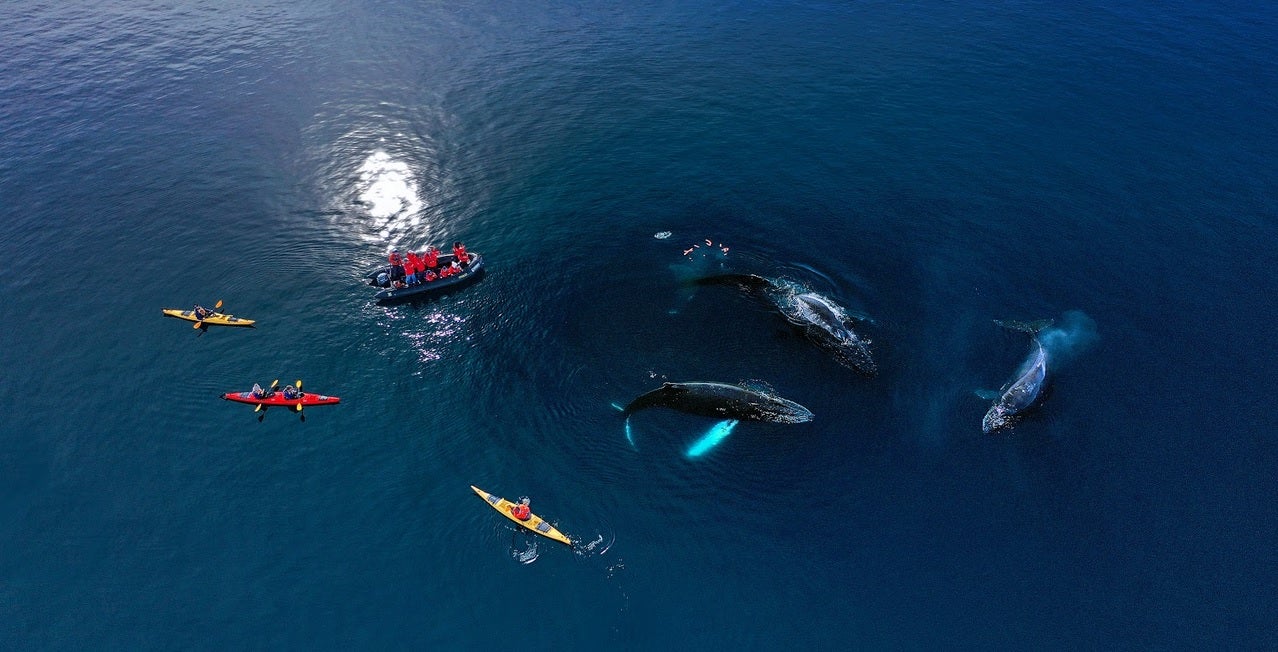
Our Editors independently research, test, and rate what we feel are the best products. We use affiliate links and may receive a small commission on purchases.
Kayakers have many reasons for putting the polar regions at the top of their must-do list of paddling destinations. Foremost among them is the chance to kayak with iconic and charismatic wildlife.
There are few experiences as exhilarating as a close encounter with a whale. Even more incredible is meeting a whale at eye level. Now add the beauty of the pristine Arctic or Antarctic environment and you have something truly amazing.
To enjoy an exceptional experience like this, you first need to book an expedition cruise with kayaking. Whale encounters from a kayak are not necessarily closer than whale encounters from a Zodiac inflatable boat or the ship itself, but being down at sea level in your own kayak with a gigantic whale is a much more intimate and humbling experience.
When and where to paddle with whales
In the Arctic, you can have the privilege of kayaking near beluga whales. Paddling with these gentle and intelligent creatures in the wild – hearing their breaths and feeling their inquisitive gaze upon you – is a life-changing experience. You may even encounter a pod – dozens of beluga or bowhead whales swimming in long procession past and underneath your kayak. Kayaking in expedition cruises is offered all season long – from late May to September.
The best time to encounter whales around the Antarctic Peninsula is December through March. When humpback whales arrive in mid-summer, they are hungry after months of fasting at their winter breeding grounds. They feed voraciously around the clock on bountiful krill in the calm waters of Gerlache Strait.
As summer advances and sea ice recedes, humpback and minke whales move farther into waterways such as Paradise Bay, Neko Harbour, Errera Channel and many others. In these protected bays and channels, kayakers have the best chance of encountering these magnificent creatures.
In February and March, after months of feeding, whales become more and more docile. Late in the season, as expected after a huge meal, humpback whales can be found resting or swimming slowly at the surface. They also seem to become more inquisitive during this time. Minke whales are more often on the move and harder to spot, but experienced kayak guides can find them among the icebergs by listening for their blows across the still waters.
Safety around whales
Kayak guides are often asked if whales pose a danger to kayakers. Whales are massive, powerful and fast, but they are not naturally aggressive toward boats or people. Even killer whales are not known to attack kayaks. It is also extremely unlikely that a whale would accidentally collide with a kayak. Though they may seem like lumbering giants, they are in fact highly intelligent and coordinated animals with total situational awareness and perfect control of their movements in the water.
However, as with any large animal, a dangerous situation may develop if interactions with whales are not handled with respect and caution. The International Association of Antarctic Tour Operators (IAATO) has developed whale-watching guidelines that apply to kayakers.
Firstly, kayakers must stop their approach at a distance of 330 feet (100 meters) from whales. It is normal for inquisitive whales to approach kayakers closer than this limit, but the whales should be in control of the distance. You must never chase or harass whales in any way. Kayakers should also stay together so as not to surround, separate or scatter a group of whales, particularly mothers and calves. When close to whales, you should avoid sudden movements and keep noise to an absolute minimum.
If the whales appear to be disturbed by your presence, then it is time to retreat slowly and quietly. Always heed the instructions of your kayak guides, who will make sure these and other guidelines are followed. In this way, kayakers and whales will enjoy a pleasant and safe mutual encounter.
What other wildlife can you spot when kayaking
In addition to possible whale encounters, kayakers in Antarctica can meet penguins and seals face-to-face in a wild polar environment full of icebergs and stunning scenery.
The Arctic has similarly wonderful animals in abundance, particularly seabirds – murres, guillemots and puffins. Kayaking at the base of seabird breeding cliffs while the chicks are jumping from the ledges into the water is a truly incredible wildlife experience.
Discover the polar paradise of your dreams as you paddle in some of the world’s most rewarding kayaking destinations!
How do I go kayaking in the polar regions?
Poseidon Expeditions offers kayaking as an optional activity on cruises to the Arctic and Antarctica aboard its expedition ship Sea Spirit. Our kayaking program lets you experience the excitement and serenity of the polar regions as part of a small, expertly guided paddling group.
In the Arctic and Antarctica, you can enjoy spectacular landscapes, crackling brash ice, towering icebergs and charismatic polar wildlife from our stable and stealthy sea kayaks. Immerse yourself in the awesome tranquility of a real wilderness while participating in an active adventure.
